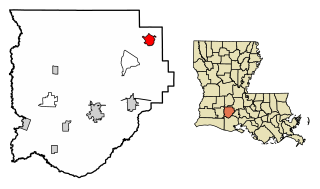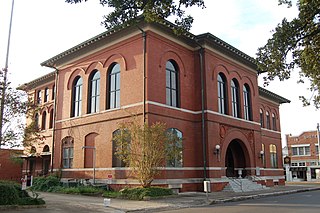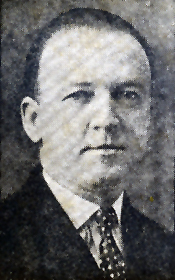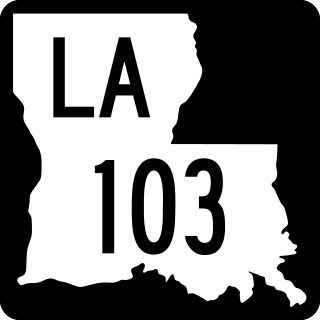
St. Landry Parish is a parish located in the U.S. state of Louisiana. As of the 2020 Census, the population was 82,540. The parish seat is Opelousas. The parish was established in 1807.

Beauregard Parish is a parish located in the U.S. state of Louisiana. As of the 2020 census, the population was 36,549. The parish seat is DeRidder. The parish was formed on January 1, 1913.

Church Point is a town in Acadia Parish, Louisiana, United States. The population was 4,560 at the 2010 census. It is part of the Crowley Micropolitan Statistical Area. Church Point is known as the Buggy Capital of the World as it used to be host to the annual Buggy Festival which has since gone defunct.

Opelousas is a small city and the parish seat of St. Landry Parish, Louisiana, United States. Interstate 49 and U.S. Route 190 were constructed with a junction here. According to the 2020 census, Opelousas has a population of 15,786, a 6.53 percent decline since the 2010 census, which had recorded a population of 16,634. Opelousas is the principal city for the Opelousas-Eunice Micropolitan Statistical Area, which had an estimated population of 80,808 in 2020. Opelousas is also the fourth largest city in the Lafayette-Acadiana Combined Statistical Area, which has a population of 537,947.

Sunset is a town in St. Landry Parish, Louisiana, United States. The population was 2,897 at the 2010 census, up from 2,352 in 2000. It is part of the Opelousas–Eunice Micropolitan Statistical Area.

Eunice is a city in Acadia and St. Landry parishes in the U.S. state of Louisiana. The 2010 census placed the population at 10,398, a decrease of 1,101, or 9.5 percent, from the 2000 tabulation of 11,499.

Arnaudville is a town in St. Landry and St. Martin parishes in the U.S. state of Louisiana. The St. Martin Parish portion of Arnaudville is part of the Lafayette metropolitan statistical area, while the St. Landry Parish portion is part of the Opelousas–Eunice micropolitan statistical area. At the 2020 population estimates program, it had a population of 1,041.
Cornelius C. Duson, was a legendary Louisiana lawman. He was the sheriff of St. Landry Parish, Louisiana from 1874 to 1888. During his career, he was known for his dogged determination.
Lebeau is an unincorporated community in St. Landry Parish, Louisiana, United States, in the central part of the state. Nearby communities include Palmetto, Ville Platte and Washington. The community is part of the Opelousas–Eunice Micropolitan Statistical Area. It is located at the intersection of U.S. Route 71 and Louisiana Highway 10.

André Bienvenue Roman was Speaker of the Louisiana House of Representatives and the ninth U.S. Governor of Louisiana.

Beau Chêne High School is a public secondary school located in southeastern St. Landry Parish between the communities of Grand Coteau and Arnaudville in the state of Louisiana, United States. The school was founded in 1991 when Sunset, Leonville, and Arnaudville High Schools were consolidated to form one centralized high school. The school serves the communities of Arnaudville, Cankton, Grand Coteau, Leonville, and Sunset. It is located at 7076 Highway 93, Arnaudville, Louisiana. Beau Chene High School has been cited for demonstrating inclusion among all their students.

Henry Dominique Larcade Jr. was a U.S. Representative from Louisiana.

St. Landry Catholic Church is a historic Roman Catholic church in Opelousas, Louisiana. It is dedicated to Saint Landry of Paris. The current church building, in Gothic and Romanesque Revival style, was completed in 1909. The church and cemetery were placed on the National Register of Historic Places in the United States on May 5, 1982. By 1792, the church had been renamed from the original title, "Parish Church of the Immaculate Conception of the Post of Opelousas".
Gilbert Louis Dupré Sr., was a self-educated lawyer and state representative from Opelousas, Louisiana, known for his initial political opposition to Governor Huey Pierce Long Jr. He held his state House seat from 1913 to 1932. A native of St. Landry Parish in South Louisiana, he maintained his legal office for many years in Opelousas.
The culture of Louisiana involves its music, food, religion, clothing, language, architecture, art, literature, games, and sports. Often, these elements are the basis for one of the many festivals in the state. Louisiana, while sharing many similarities to its neighbors along the Gulf Coast, is unique in the influence of Louisiana French culture, due to the historical waves of immigration of French-speaking settlers to Louisiana. Likewise, African-American culture plays a prominent role. While New Orleans, as the largest city, has had an outsize influence on Louisiana throughout its history, other regions both rural and urban have contributed their shared histories and identities to the culture of the state.
Michael Huval, also known as Mike "Pete" Huval, is an American politician and insurance agent from Breaux Bridge, Louisiana, currently serving as a Republican member of the Louisiana House of Representatives for District 46 in St. Martin Parish.

Louisiana Highway 103 is a state highway in St. Landry Parish, Louisiana, United States, that spans 39.5 miles (63.6 km) in a wide semi-circle around the north side of Opelousas. The route is not bannered but runs in an overall west–east direction from U.S. Highway 190 near Lawtell to LA 31 in Leonville. Along the way, it passes through the towns of Washington and Port Barre.

The Opelousas massacre, which began on September 28, 1868, was one of the bloodiest massacres of the Reconstruction era in the United States. In the aftermath of the ratification of Louisiana's Constitution of 1868 and the Fourteenth Amendment to the United States Constitution, tensions between white Democrats and Black Republicans in St. Landry Parish, Louisiana escalated throughout the summer of 1868. On September 28, white schoolteacher and Republican newspaper editor Emerson Bentley was attacked and beaten by three, Democratic white supremacists while teaching a classroom of Black children in Opelousas, Louisiana. Rumors of Bentley's death, while unfounded, led both Black Republicans and white supremacist Democrats, including the St. Landry Parish chapter of the Knights of the White Camelia, to threaten violent retribution. In the days following Bentley's subsequent covert flight to New Orleans, the massacre began. Heavily outnumbered, Black citizens were chased, captured, shot, murdered, and lynched during the following weeks. While estimates of casualties vary widely, several sources number the deaths between 150 and 300 black people and several dozen whites. Following the massacre, the Republican Party in St. Landry Parish was eliminated for several years.
Edmond Ducre Estilette, known as E. D. Estilette, was a politician and lawyer in Opelousas, Louisiana. He served in a number of public positions, most notably speaker of the Louisiana House of Representatives at the end of Reconstruction in 1875. Estilette oversaw the creation of one of the most infamous Black Codes of the post-Civil War era, but he was later seen as a moderating force in the turbulent politics of that era.













